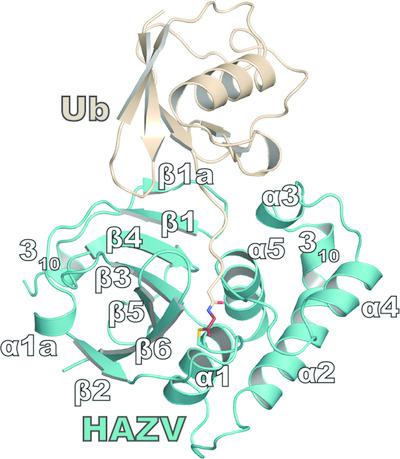当前位置:
X-MOL 学术
›
Acta Cryst. D
›
论文详情
Our official English website, www.x-mol.net, welcomes your
feedback! (Note: you will need to create a separate account there.)
Flipping the substrate preference of Hazara virus ovarian tumour domain protease through structure‐based mutagenesis
Acta Crystallographica Section D ( IF 2.6 ) Pub Date : 2020-11-02 , DOI: 10.1107/s2059798320012875 John V Dzimianski 1 , Savannah L Mace 1 , Isabelle L Williams 1 , Brendan T Freitas 1 , Scott D Pegan 1
Acta Crystallographica Section D ( IF 2.6 ) Pub Date : 2020-11-02 , DOI: 10.1107/s2059798320012875 John V Dzimianski 1 , Savannah L Mace 1 , Isabelle L Williams 1 , Brendan T Freitas 1 , Scott D Pegan 1
Affiliation

|
Nairoviruses are arthropod‐borne viruses with a nearly global geographical distribution. Several are known causative agents of human disease, including Crimean–Congo hemorrhagic fever virus (CCHFV), which has a case fatality rate that can exceed 30%. Nairoviruses encode an ovarian tumour domain protease (OTU) that can suppress the innate immune response by reversing post‐translational modifications by ubiquitin (Ub) and/or interferon‐stimulated gene product 15 (ISG15). As a result, the OTU has been identified as a potential target for the development of CCHFV therapeutics. Despite sharing the same general fold, nairoviral OTUs show structural and enzymatic diversity. The CCHFV OTU, for example, possesses activity towards both Ub and ISG15, while the Hazara virus (HAZV) OTU interacts exclusively with Ub. Virology studies focused on the OTU have mostly been restricted to CCHFV, which requires BSL‐4 containment facilities. Although HAZV has been proposed as a BSL‐2 alternative, differences in the engagement of substrates by CCHFV and HAZV OTUs may present complicating factors when trying to model one using the other. To understand the molecular underpinnings of the differences in activity, a 2.78 Å resolution crystal structure of HAZV OTU bound to Ub was solved. Using structure‐guided site‐directed mutagenesis, HAZV OTUs were engineered with altered or eliminated deubiquitinase activity, including one with an exclusive activity for ISG15. Additionally, analysis of the structure yielded insights into the difference in inhibition observed between CCHFV and HAZV OTUs with a Ub‐based inhibitor. These new insights present opportunities to utilize HAZV as a model system to better understand the role of the OTU in the context of infection.
中文翻译:

通过基于结构的诱变翻转哈扎拉病毒卵巢肿瘤结构域蛋白酶的底物偏好
内罗病毒是节肢动物传播的病毒,地理分布几乎遍及全球。有几种已知的人类疾病病原体,包括克里米亚-刚果出血热病毒 (CCHFV),其病死率可能超过 30%。内罗病毒编码卵巢肿瘤结构域蛋白酶 (OTU),它可以通过逆转泛素 (Ub) 和/或干扰素刺激的基因产物 15 (ISG15) 的翻译后修饰来抑制先天免疫反应。因此,OTU 已被确定为开发 CCHFV 疗法的潜在靶点。尽管具有相同的一般折叠,内病毒 OTU 显示出结构和酶促多样性。例如,CCHFV OTU 对 Ub 和 ISG15 均具有活性,而哈扎拉病毒 (HAZV) OTU 仅与 Ub 相互作用。针对 OTU 的病毒学研究大多局限于 CCHFV,这需要 BSL-4 遏制设施。尽管 HAZV 已被提议作为 BSL-2 的替代方案,但在尝试使用其中一种进行建模时,CCHFV 和 HAZV OTU 与底物的接合差异可能会带来复杂的因素。为了了解活性差异的分子基础,我们解析了与 Ub 结合的 HAZV OTU 的 2.78 Å 分辨率晶体结构。使用结构引导的定点诱变,HAZV OTU 被设计为具有改变或消除的去泛素酶活性,其中包括一种具有 ISG15 独有活性的 HAZV OTU。此外,结构分析还深入了解了基于 Ub 的抑制剂在 CCHFV 和 HAZV OTU 之间观察到的抑制差异。这些新见解提供了利用 HAZV 作为模型系统的机会,以更好地了解 OTU 在感染背景下的作用。
更新日期:2020-11-02
中文翻译:

通过基于结构的诱变翻转哈扎拉病毒卵巢肿瘤结构域蛋白酶的底物偏好
内罗病毒是节肢动物传播的病毒,地理分布几乎遍及全球。有几种已知的人类疾病病原体,包括克里米亚-刚果出血热病毒 (CCHFV),其病死率可能超过 30%。内罗病毒编码卵巢肿瘤结构域蛋白酶 (OTU),它可以通过逆转泛素 (Ub) 和/或干扰素刺激的基因产物 15 (ISG15) 的翻译后修饰来抑制先天免疫反应。因此,OTU 已被确定为开发 CCHFV 疗法的潜在靶点。尽管具有相同的一般折叠,内病毒 OTU 显示出结构和酶促多样性。例如,CCHFV OTU 对 Ub 和 ISG15 均具有活性,而哈扎拉病毒 (HAZV) OTU 仅与 Ub 相互作用。针对 OTU 的病毒学研究大多局限于 CCHFV,这需要 BSL-4 遏制设施。尽管 HAZV 已被提议作为 BSL-2 的替代方案,但在尝试使用其中一种进行建模时,CCHFV 和 HAZV OTU 与底物的接合差异可能会带来复杂的因素。为了了解活性差异的分子基础,我们解析了与 Ub 结合的 HAZV OTU 的 2.78 Å 分辨率晶体结构。使用结构引导的定点诱变,HAZV OTU 被设计为具有改变或消除的去泛素酶活性,其中包括一种具有 ISG15 独有活性的 HAZV OTU。此外,结构分析还深入了解了基于 Ub 的抑制剂在 CCHFV 和 HAZV OTU 之间观察到的抑制差异。这些新见解提供了利用 HAZV 作为模型系统的机会,以更好地了解 OTU 在感染背景下的作用。











































 京公网安备 11010802027423号
京公网安备 11010802027423号